Earthquake Chasing with FTF Engineering
Author: John Dal Pino
Contributors: Claire Hu, Elizabeth Bognar, and Hongxun Yang
Below is an inside look at John’s full report on Ferndale.
Introduction & Objectives
Between Christmas and New Year’s, I led a small group of young FTF engineers on a long day trip to the California North Coast to learn from the December 20, 2022, 6.4 magnitude (Modified Mercalli Intensity VIII, Severe) Ferndale earthquake. Our goal was to visit Scotia, Rio Dell, Ferndale, Eureka, and anything else that caught our eye. For me, the goal was three-fold: first, to take the opportunity to personally learn something new from a “local” earthquake and share our experiences with clients. Secondly, to provide the FTF staff who joined me with their first opportunity to go on what is commonly called an “earthquake chase.” Thirdly, share our experiences with the broader community to place seismic hazard mitigation in a prominent view.
Based on the first press reports, my expectations for learning about contemporary building types were low, but I have learned over the years that you can always find a few nuggets if you look or think hard enough. I strongly recommend doing what we did after a future earthquake. Seeing something up close in the context of the local building inventory and their construction informs the observer in a way that photographs from recent or long past earthquakes cannot. I assume that engineers in other parts of the country do their own “chasing” after damaging windstorms, floods, fires, or snowfalls. Their experiences could be more well-documented and more widely published.
Background
To start, we want to provide an overview description of the location, the typical construction, the regional seismicity, and then what our team witnessed. The North Coast is a large redwood forest stretching south-north from a few hours north of San Francisco to the California-Oregon border and west-east from the coast to the north-south centerline of California (roughly Interstate 5). The primary industry has always been and will probably remain lumber. Wood provides the major building material, and the wood industry employs most of the local population with commerce related to and sustained by the redwood forest, mainly tourism.
Except for institutional buildings (hospitals, police stations, telephone exchanges, and so on) and a sprinkling of newer apartment buildings in Eureka (the largest city and main population center), most buildings are one and two-story stick-framed or heavy timber structures. Besides Eureka, the next largest city is Ferndale, followed by the smaller towns of Scotia, Rio Dell, Fortuna, and Petrolia. Some of the banking, commercial and residential buildings in each city are pretty grand and in the Victorian style, particularly in Ferndale, dating to the late 1800s (considered old in California) when lumber was king. The dairy industry is also significant in the local economy.
According to the USGS, the area is the most seismically active in California. There have been 40 or more earthquakes above Magnitude 6 in the last 100 years. Most of us know about the “ring of fire,” that tectonic plate boundary circling the Pacific Ocean, see Figure 1. Along most of the California Coast, the plate boundary is the famous strike-slip San Andreas fault. But the part of the ring starting roughly at and running northward from the Oregon-California border is the Cascadia subduction zone, where the Pacific plate dips under the North American plate. The melting of the Pacific plate is responsible for the string of volcanoes that start with Mt. Shasta (roughly due east of Mendocino) and ends with Mt. Rainer near Seattle. Mendocino Triple Junction(where the San Andreas, Cascadia collides with the part caught in the middle, the Mendocino Fracture Zone) is complicated and seismically active.
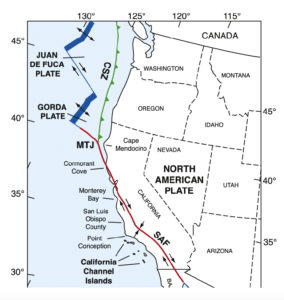
For a bit of recent history, on April 25, 1992, there was a 7.2 magnitude (maximum Modified Mercalli Intensity IX, Violent) earthquake with an epicenter near the small town of Petrolia. The main event was followed the next day by two large aftershocks measuring M6.5 and M6.6 on the Richter scale. I visited the area following the earthquake and witnessed significant damage in Scotia, Petrolia, and Ferndale. The total number of aftershocks that followed the main events exceeded 2,000.

Source: State of California, Department of Conservation 4
The geologic and site soil conditions always play an essential role in the severity of the ground shaking and any resulting earthquake damage. It is crucial for non-engineers and earthquake-chasing engineers to remember that buildings founded on rock generally perform better than those based on softer and deeper softer soils; softer soils magnify the ground motions that buildings feel. The mouth of the Eel River, where this earthquake was mostly felt, is in a broad alluvial plain with a deep soil profile (triangularly-shaped pale-yellow area), see Figure 2. Ferndale is located on the south side of the alluvial plain, while Rio Dell and Scotia are located near the east end. Eureka, southeast of Arcata Bay, has similar soil.
Our Earthquake Chase
Before the trip, we visited the California Strong Motion Instrumentation Program (CSMIP) website and downloaded ground motion and instrumented building data to focus our attention and make the most of our trip. CSMIP has placed accelerometers (free field and on buildings) across California so researchers can link observed earthquake damage with the recorded local earthquake ground motions (accelerations, velocities, and displacements).
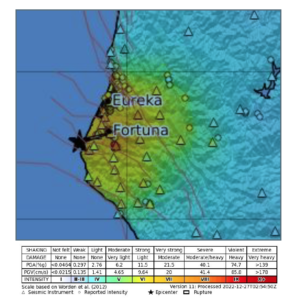
Source: USGS 5
Without the earthquake data, engineers can learn from the observed damage, but like in a car crash, one cannot learn much from the result if the car’s speed is unknown. With the recorded data, structural engineers can gauge whether the building codes and standards they use are targeted properly (too lax or too stringent) at the typical goal of life safety in all but the strongest possible earthquakes. The USGS has stated that the recent earthquake occurred in the Mendocino Fracture Zone on a horizontal planar fault. Figure 3 shows the USGS Shake Map for the area.
Scotia
We started the day in Scotia (population approximately 1,000), mainly because it was the southernmost of our destinations. But also because of the significant damage I saw there in 1992. Pacific Lumber Company constructed Scotia as a “company town” for workers in the local mill with many modest one-story wood homes. The above-grade buildings have the first floor supported on wood posts with small concrete footings. Crawl spaces are enclosed with spaced vertical sheathing to allow for ventilation (it rains a lot on the North Coast). The crawl spaces were not braced or minimally braced, creating a soft/weak story condition. In the 1992 earthquake, many of these homes experienced a collapse in the crawl space.
The Scotia homes are representative of traditional California construction before the advent of the slab-on-grade building, predominately used today in mass-produced tract homes. During our recent visit, we can happily report that we saw no collapses or significant damage. We witnessed retrofitting to many of the buildings with diagonal wood bracing. Continuous concrete footings with the plywood sheathing used to brace the crawl space now support other structures. A success story for seismic retrofit, but we need ground motion data to judge the extent of the success.
Rio Dell
Just over the Eel River, one mile north of Scotia is the town of Rio Dell (population approximately 3,400). Rio Dell is a modest community of small, primarily one-story homes, a few commercial buildings along the main street (Wildwood Avenue), an elementary and middle school, and so on. Rio Dell experienced the most damage we observed on our trip. CSMIP records indicated a Sa at the one-second period of 0.5g to 0.75g. The California Building Code requires roughly this design force for structures in the San Francisco Bay Area not located near active faults. The design requirements for new local buildings are quite higher, with 2.07g in the 0.3-second period and 1.2g in the one-second period.
The damage consisted of:
i. Houses off foundations and failures of house foundations
iii. Collapse of residential porch covers
iv. Mobile homes off supports
v. Fallen chimneys
vi. Minor structural damage
Modest retrofits like those we witnessed in Scotia would have easily prevented the damage. We spoke with a few residents who told us they lacked earthquake insurance because of the high cost (approximately $1,500 per year). Many residents also probably lacked the financial means to make significant home investments. According to the 2000 census, the median household income in Rio Dell was roughly $30,000, with approximately 25% of the population living below the poverty line. On Painter Street, we saw two nearly identical homes, one with a retrofitted foundation and crawl space and one without (see Figures 4, 5A, and 5B). According to the Zillow website, the asking price for a similarly damaged home was $330,000.
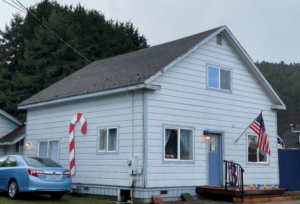
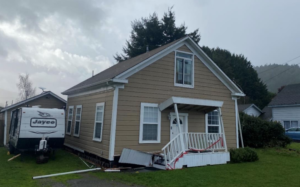
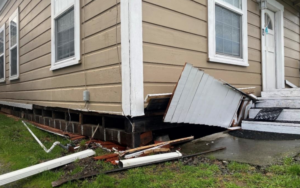
Also, on Painter Street, we observed a home with no apparent damage other than a badly cracked, unreinforced concrete foundation. We are all too aware of the risk associated with unreinforced brick masonry foundations, but low-strength concrete foundations appear to be not much better (see Figures 6A and 6B). The homeowner told us that a contractor had estimated the repair cost at $35,000. Using Zillow data, the house price would fall in the $200,000 to $250,000 range. At a 15% deductible based on replacement value for a California Earthquake Authority (CEA) policy, the damage may not be covered or only minimally covered by insurance.
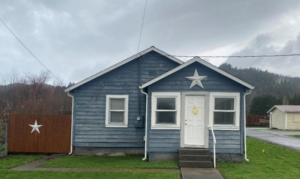
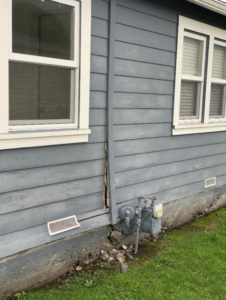
We also spoke with the owner of the now famous home (according to the friendly and good-spirited owner) on Wildwood Avenue with the collapsed front porch cover (see Figures 7A before and 7B after). He said that in the 1992 earthquake, the chimney had collapsed and crushed a nearby car. The firebox portion was retained and did not suffer any damage in the recent earthquake.
The owner invited us inside; we could see that the earthquake shook the house vigorously, resulting in several small cracks and joint separations in the interior. He told us that many items had fallen from shelves. Upon close inspection of the exterior, we could see that the porch cover was only minimally attached to the exterior wood sheathing at the time of original construction. A small investment in improving the attachment to the house would have eliminated this significant life-safety hazard.
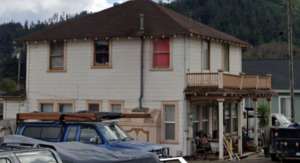
(From Google Street View)
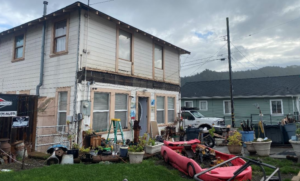
On Painter Street, we saw two mobile homes that had fallen from stacked concrete masonry blocks. The cost of cable bracing, which would prevent such damage, is small by almost any measure. We observed two chimney collapses, one on an older residential structure on Davis Street close to the Eel River (see Figures 8A, 8B, and 8C) and one at a church on Belleview Avenue (see Figure 9).
The Davis Street chimney was tall, newer than the house itself, and maybe reinforced. It was not attached to or minimally attached to the structure. Regardless, the chimney collapsed since the house would not have had the lateral strength to support it. At the Belleview Avenue location, the chimney was more modern, shorter, and of reinforced CMU block construction. In the debris pile, we saw the reinforcement and straps used to attach it to the structure. But it fell too. Brick chimneys are a generally bad idea for wood buildings. Unless designed to be self-supporting, they should be removed and replaced with lightweight construction (wood exterior box, triple insulated stainless steel flue, and metal firebox).

(From Google Street View)
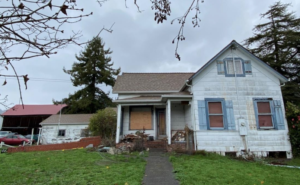
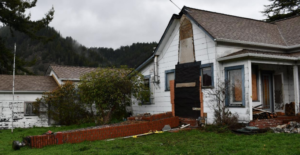

In a testament to the superior performance of reasonably well-designed wood construction, we saw very little damage of a structural nature. While observing the emergency support services offered at the elementary/middle school on Center Street, we stumbled upon a Napa Auto Parts store and an adjacent former commercial building currently part of the school (see Figures 10A and 10B). Before the earthquake, thin wood panels (to hide the storage inside) covered the large plate glass windows. Brad-type nails held these in place. During the earthquake, the plate glass broke, the wood panels were loosened with the nails pulling out, and finally, the narrow wall piers resisted the lateral load. The wall piers sustained base rotation and cracked the stucco. We suspect that there were no seismic holdown anchors.
Though not of major significance in the grand scheme of engineering, the sequential nature of the structural response was instructive to the FTF team, namely that in smaller events, all elements capable of resisting lateral forces (structural and non-structural) will do so. Still, it is up to the engineered structural parts to do the heavy lifting in increasingly larger events.
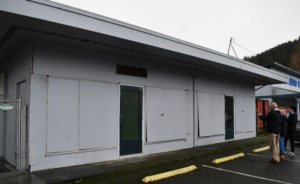

Ferndale
Next up was Ferndale (population of approximately 1,400). The bridge over the Eel River appeared damaged at the abutments. Myers Construction, the specialty contractor often used by Caltrans for their ability to accomplish major tasks quickly, was on the scene. It would have taken more time than we could afford to get access, so we will continue to monitor the situation and report later.
Like Scotia, we can happily report that we saw no signs of significant structural and non-structural damage in Ferndale, except for a few broken windows on the main downtown street. CSMIP records at the Ferndale Fire Station indicated a Sa 0.73 at the 0.3 second period and 0.4g at the one-second period; which is roughly 75% of the design force the California Building Code requires for the design of new structures in the San Francisco Bay Area not located close to active faults.
There was extensive damage in Ferndale from the 1992 event, but the repaired residential buildings performed well. As mentioned above, the town has a large inventory of grand Victorian-style construction dating to the late 1880s; see Figures 11A, 11B, and 11C. The commercial buildings are on Main Street, and the residential buildings are in an adjacent neighborhood to the southeast. Many of the businesses on Main Street were closed for the holidays, so we could not determine the extent of strengthening following the 1992 event. However, except for the broken glass, it would be difficult to detect signs that a significant earthquake has recently occurred. We did not observe steel frames commonly employed to stiffen the storefronts of commercial buildings. We intend to investigate local retrofit ordinances and past retrofit work further.
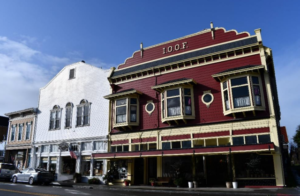
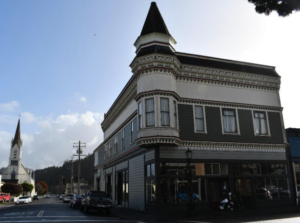

Eureka
Our final stop was Eureka (a population of approximately 27,000). Based on the press reports, we did not expect to observe much damage. Still, we were intrigued by CSMIP records showing strong ground motions at the instrumented four-story Providence St. Joseph Hospital on Dolbeer Street and the five-story Silvercrest Senior Housing building on Tydd Street. Their locations on the bluff east of the downtown boast firm soils compared to the downtown below or the Eel River floodplain.
CSMIP records at the hospital show a Sa of 0.464g at the 0.3-second period and 0.444g at the one-second period and the senior housing building of 0.859g at the 0.3-second period and 0.239g at the one-second period. The design ground motions are 2.27g at the 0.3-second period and 1.23g at one-second. We did not witness any damage at either location. The hospital consists of an older concrete building on the west and a newer braced-frame steel building on the east, see Figure 12. We would not have expected any structural damage to the hospital for the recorded ground motions. Still, we did not see the telltale signs of ongoing repairs to non-structural elements, particularly plumbing systems.
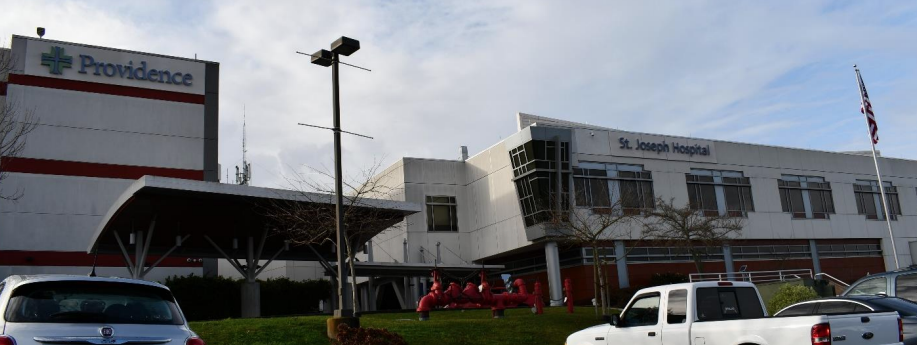
The senior housing is a concrete flat plate building with concrete masonry (CMU) columns and flanged CMU shear walls, see Figures 13A and 13B. We walked the entire perimeter and observed no wall cracking.

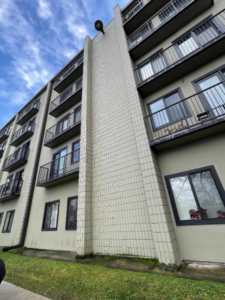
Conclusions
Given our objectives, we judged the day as a successful learning experience for everyone. As I mentioned at the beginning, take the opportunity to go earthquake chasing if you can. You will likely learn something new. You will also meet the people directly affected by the natural disaster, observe how communities help displaced individuals and gather your thoughts on crafting disaster recovery public policy.
Our engineering takeaways were:
- Well-designed seismic retrofits targeting well-known vulnerabilities pay off handsomely. Financial assistance and incentives for retrofits in advance will lessen the impact on communities and improve resilience.
- Even moderately strong earthquakes have a way of pointing out to everyone seismic vulnerabilities that are in plain view of people who should know. Communities should encourage continuous mitigation, basically chipping away at a very long list rather than waiting for a damaging event to occur.
- In terms of protecting life safety, wood frame construction performs reasonably well in almost all instances.
- Admittedly, based on a small sample size in one earthquake, CEA-style 15% deductible insurance coverage may only kick in for the largest earthquakes. The more financially prudent approach is proactively retrofitting to address risks from strong and lesser earthquakes. For code-compliant recently constructed homes or well-retrofitted older homes, the repair cost for even the largest earthquakes may be less than one might assume (a good thing), but insurance might be worthwhile if it helps to sleep at night.
- Masonry chimneys represent the most significant hazard and should be demolished and replaced in almost all situations.
- There is a need for seismic vulnerability education and outreach to populations in economically challenged regions. Financial incentives or small investments of public monies to address the most basic of known earthquake hazards would yield great societal benefits.
